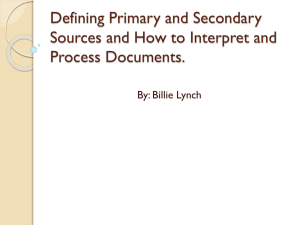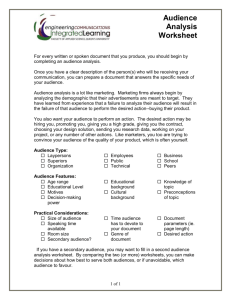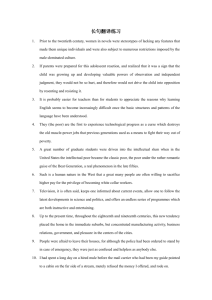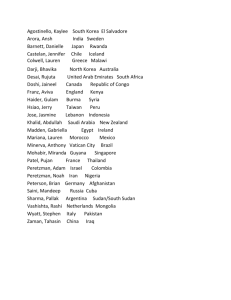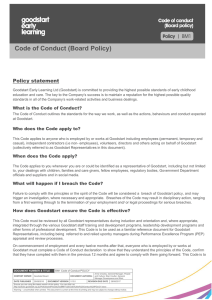Assignment 1
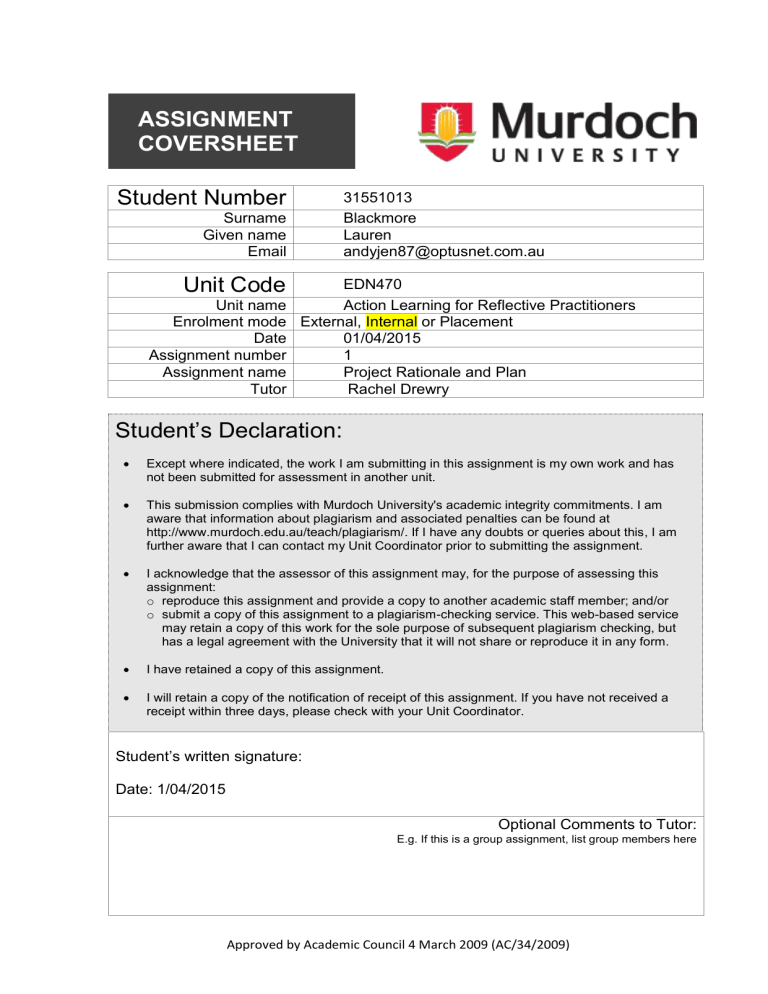
ASSIGNMENT
COVERSHEET
Student Number
31551013
Surname Blackmore
Given name Lauren
Email andyjen87@optusnet.com.au
Unit Code
EDN470
Unit name Action Learning for Reflective Practitioners
Enrolment mode External, Internal or Placement
Date 01/04/2015
Assignment number 1
Assignment name Project Rationale and Plan
Tutor Rachel Drewry
Student’s Declaration:
Except where indicated, the work I am submitting in this assignment is my own work and has not been submitted for assessment in another unit.
This submission complies with Murdoch University's academic integrity commitments. I am aware that information about plagiarism and associated penalties can be found at http://www.murdoch.edu.au/teach/plagiarism/. If I have any doubts or queries about this, I am further aware that I can contact my Unit Coordinator prior to submitting the assignment.
I acknowledge that the assessor of this assignment may, for the purpose of assessing this assignment: o reproduce this assignment and provide a copy to another academic staff member; and/or o submit a copy of this assignment to a plagiarism-checking service. This web-based service may retain a copy of this work for the sole purpose of subsequent plagiarism checking, but has a legal agreement with the University that it will not share or reproduce it in any form.
I have retained a copy of this assignment.
I will retain a copy of the notification of receipt of this assignment. If you have not received a receipt within three days, please check with your Unit Coordinator.
Student’s written signature:
Date: 1/04/2015
Optional Comments to Tutor:
E.g. If this is a group assignment, list group members here
Approved by Academic Council 4 March 2009 (AC/34/2009)
Lauren Blackmore
EDN470
31551013
EDN470: Project Rationale and Plan
Assignment 1
Sandra Hesterman
http://www.apnatalks.com/child-is-like-a-bird-wings-quotes/
By Lauren Blackmore
31551013
2 | P a g e
Lauren Blackmore
EDN470
31551013
Contents
3 | P a g e
Lauren Blackmore
EDN470
31551013
Project Title
Finding ways to enhance student’s mathematical understanding using authentic play-based approaches instead of worksheet based activities.
Project Title Keywords
Play-based approach: Play based learning capitalises on children’s natural sense of inquiry and discovery through hands-on exploration of the world around them. (Goodstart Early Learning. 2015)
Authentic learning: Authentic learning is real life learning, they are real life tasks, or simulated tasks that provide the learner with opportunities to connect directly with the real world. The teacher becomes a guide on the side or an event manager, a facilitator not a dictator. (Revington, 2012)
Worksheet based activities: Usually teacher made worksheets that typically require the learner to connect ideas, complete a blank space, circle the correct answer, copy the text, or match images and letters. Usually based on only one idea or skill. (Flemington, Hart-Hewins, & Villiers, 2011)
Project Rationale
Children learn so much through play. It allows them to explore, discover, negotiate, take risks, create meaning and solve problems – all the important foundations for developing literacy, numeracy and social skills (Goodstart Early Learning. 2015). Yet unfortunately you can walk into many classrooms today to still find teachers handing out worksheet after worksheet to students throughout the day.
Why? Yes, it might save time, easier for the teacher and quick to produce but really, how effective are they? Are the students actually getting anything out of them? It were these questions that I was asking myself which lead me to want to step out of my comfort zone and expand my teaching approaches.
I began by reflecting on my previous practical experiences and asked myself what is it that I really want to improve on. I remember one of my very first mentor teachers telling me that the only way to get students to do great work and really learn from the activity is if you make it mean something to them. Make them feel as though they are not working but instead exploring (Retallack, 2011).
Thinking back to my school days I was a very active learner. I loved working with my peers, getting up and outdoors to explore and experiment, and being hands on in the learning activity. It’s because of this, I have such a strong passion to want to break out of the worksheet, sat at your desk style of teaching. I admit when in the classroom, I can get a bit overwhelmed and opt for the safety net of a worksheet to help control my lesson. Worksheets don’t extend thinking; Questions indicate that students have been thinking about the ideas presented and have been trying to extend and link them with other things they know; (Chin, 2002) but if unable to link the question to anything meaningful, their level of motivation will completely drop off and the activity will have little to no benefit. It was this that provided the fuel for this project.
As I started looking into ‘play’ in a primary setting, I found that there is a lot more to it than what I first thought. There are three types of play that occur for young children that I need to take into consideration. There’s self-directed play; where students build forts and castles and imaginary worlds where they make up their own rules. There’s organizational play; a game that has been organized for them with structured rules e.g. soccer game. Finally there’s educational play; where the teacher structures the environment to ensure that optimal learning will take place (Flemington et al., 2011). Getting the right balance between all three provides the challenge that I am looking for
4 | P a g e
Lauren Blackmore
EDN470
31551013 within this assignment as this is a chance to extend and push forward my teaching practices and break away from worksheets.
My chosen school
All Saints College is an independent school which is situated in a medium socio-economic area. There are currently 1134 students enrolled who range from pre-kindergarten to year 12 where there are
106 teaching staff in total. [Yr group and exact class details still unknown at current time due to late school swap]
Action Research Methodology
Action research is simply a form of self-reflective enquiry undertaken by participants in social situations in order to improve their own practices, their understanding of these practices, and the
situations in which the practices are carried out (Carr, & Kemmis, 2004). This project is giving me the chance to become a critical reflector within my teaching practices. The main focus of action research is simply to reflect and improve within your practice. Through feedback from my previous mentor teachers, and my own personal beliefs, I not only see how dependant I can get always relying on worksheets but a play based approach is something I have a big passion for and something I want to bring into my own teaching style. I truly believe that students don’t get much out of filling in a worksheet because they don’t have to think about why they are doing it. After seeing firsthand the number of teachers that still rely heavily on worksheets, I have taken this project as an opportunity to see just how effective a play-based approach is and whether it is more beneficial to the students.
Throughout this inquiry, I will be constantly questioning, experimenting, reflecting and deciding on my next course of action throughout my action research plan. Kurt Lewin has been said to have come up with the term ‘action research’, which he describes as reflective thought, discussion, decision and action by ordinary people participating in collective research on "private troubles"
(Adelman, 1993).
I see action research as being split into 4 categories within a continuous cycle. Reflect, plan, act and observe. Reflect is both the start and the end of the cycle. First you reflect on what the problem is, or the area in which you would like to improve on. This leads to devising a plan. What are you going to do, how are you going to do it, when, where etc. It is now time to act on your plans. For myself, this will be inside an early childhood classroom where I will be working with a small group of students. While this is happening, observing is crucial. How is your plan working, how are the students responding, what teaching strategies are/are not working, look at the environment, my personal persona, take a look at student work samples etc. Once this has all happened you need reflect. Becoming a critical reflector is crucial in order to see change and progression. It is this cycle that will be the key to seeing a positive educational change within classrooms (Australia.
Department of Education and Training,. 2010). For me personally, it is my chance to improve my teaching skills and practices in an area that I feel so passionately about.
Project Aims Statement
To use authentic, play-based approaches instead of worksheets to enhance mathematical understanding.
My aims
1.
My aim is to feel more confident using play based approaches throughout a maths lesson and not have to rely on worksheets to be the main focus.
5 | P a g e
Lauren Blackmore
EDN470
31551013
2.
It is my aim that this project will give me the experience and better understanding of how authentic, play-based activities can provide better learning opportunities for students.
3.
It is my aim throughout this project to gain strategies and a better understanding of how to run a play-based lesson which has a purpose and provides intentional learning opportunities.
Focus Research Questions
1.
How will I know whether the students are getting my intended learning goal through my play-based activities and not just self-directing their own play?
2.
How will I ensure that my authentic, play-based activities are giving my students a greater mathematical understanding rather than using worksheets?
3.
What strategies will I have to use to ensure intentional play based learning occurs?
4.
What items of evidence will I use to assess students learning throughout various play-based approaches?
Project Plan
Strategies to be used
Play based provocations:
Getting away from continual use of worksheets is my biggest challenge and focus for this project. A
Provocation is something that sparks questions, interest, ideas, theories, discussion, debate and engages the children's thinking (Dowling & Parrott, 2014). In order to provide an authentic learning experience so that the students can connect and make real life meaning, they will need to be interested, drawn in and wanting to take part. For play to be beneficial, it needs to be effectively scaffolded, with careful reflection on organisational details such as time, resources and materials
(Trimble-Roles, 2012). Providing play-based provocations will do just that if executed correctly on my behalf, which intern will provide a greater mathematical understanding for my students.
Intentional teaching:
I see intentional teaching as going hand in hand with educational play. In fact, for play based learning to work, Intentional teaching has to be at the forefront when planning for each lesson.
Intentional teaching is a term that is used to describe teaching that is purposeful, thoughtful and deliberate (DEEWR, 2009). Intentional educators do not assume that children’s development will happen without support, encouragement, and scaffolding or without presenting appropriate challenges for the children (Gronlund & Stewart, 2011). It will be very easy to bring out a whole load of hands on materials instead of worksheets to teach mathematical ideas and let the children play around with them. My focus will be on making sure I provide a purpose for each of the materials.
Collaborative learning with mentor teacher:
Collaboration enhances the professional learning of early childhood professionals (Flottman,
McKernan & Tayler, 2011). To be able to effectively run an authentic lesson, you need to know your students. What interests do they have, what makes them excited, switches them on? In such a small
6 | P a g e
Lauren Blackmore
EDN470
31551013 time I have with my group, getting this knowledge will prove difficult. My mentor will obviously have a sound understanding behind every student, how they learn best and what their interests are. Early childhood professionals should communicate openly with one another, plan collaboratively and work in ways that support children’s learning and development (Flottman et al., 2011). Working with my mentor teacher will provide me with different perspectives and views from what I have and will hopefully broaden my strategies and teaching approaches.
Use of tape recording:
Careful listening to what students have to say has been shown to be an important aspect of practice
(Carpenter & Fennema (as cited in Davies et al, 2007)). Sometimes when students talk to the teacher, they can close up. I find you can get a much deeper understanding of their knowledge when you listen to them talk out aloud to their peers, as these discussions create natural questions and answers. A tape recording will be able to pick up all these informal spontaneous chats to allow myself to get a greater understanding of how effective my play based activities are and whether they are actually connecting and making meaning from the authentic experiences. “Listening to your students is the crucial factor that contributes to more effective mathematics instruction (Carpenter
& Fennema (as cited in Davies et al, 2007)).
Proposed items of Evidence
1.
Audio taping- A chance to record students voices throughout activities when speaking to their peers and myself as the teacher. Able to gain a deeper understanding of their thoughts and knowledge on each specific activity through what they say. As this project focus is on our personal teaching practices, audio taping will give me a fantastic opportunity to listen to my instruction giving, questioning and use of language. A useful tool for self-reflection at the end of the activity.
2.
Observations – Writing down observations throughout the lesson on student responses, questions asked, crucial teaching moments and general observations. Also a chance to write down my own personal thoughts and actions straight after I have given instruction so that I am able to review how I went and self-reflect on my confidence throughout.
3.
Students work samples – A fantastic way of getting concrete evidence of student’s mathematical understanding and knowledge. A way of identifying student’s strengths and weaknesses.
4.
Notes from a critical friend – Receiving notes from my critical friend will provide me with feedback on my teaching practices. Feedback commenting on my strengths, weaknesses and areas I need to improve on. My critical friend will also provide me with new teaching strategies and ideas that I will hopefully be able to implement into my future teaching. A critical friend takes the time to fully understand the context of the work presented and the outcomes that the person or group is working toward (Costa, & Kallick, 1993). They will have a full understanding of my goals over the 30 hours and what I am wanting to achieve.
Word count: 2096
7 | P a g e
Lauren Blackmore
EDN470
31551013
Appendices
Timeline
Please see Appendices
Provisional Reading list
Australian Curriculum, Assessment and Reporting Authority, (2014). Retrieved from, http://www.australiancurriculum.edu.au/
Ferrance, E., (2000). Themes in Education: Action Research. Retrieved from, http://www.brown.edu/academics/education-alliance/sites/brown.edu.academics.educationalliance/files/publications/act_research.pdf
Flemington, K., Hart-Hewins, L., & Villiers, U. (2011). Journey to literacy: No worksheets required.
Markham, Canada: Pembroke Publishers
Frey, B. B., Schmitt, V. L., & Allen, J. P. (2012). Defining Authentic Classroom Assessment. Practical
Assessment, Research and Evaluation, 17(2), 18. Retrieved from, http://pareonline.net/getvn.asp?v=17&n=2
Koshy, V., (2009). Action Research for Improving Educational Practice: A Step-by-Step Guide
(2nd ed.). London, United Kingdom: Sage Publications
Miller, A. (2015). Bringing Authenticity to the Classroom | Edutopia. Retrieved from http://www.edutopia.org/blog/bringing-authenticity-to-the-classroom-andrew-miller
Northern Territory government, Department of Education, (2004). Strong beginnings: An Explicit
Guide to Quality Practice in the Early Years. Retrieved from, http://www.education.nt.gov.au/teachers-educators/curriculum-ntbos/support-materials/strongbeginnings
Tucker, K. (2010). Mathematics through play in the early years (3rd ed.). Los Angeles: Sage
Publications.
Vaccarino, F., Comrie, M., Murray, N & Sligo, F., (2007). Action Research Reflections: The Wanganui
Adult Literacy and Employment Project. Massey University, New Zealand. Retrieved from, http://www.massey.ac.nz/massey/fms/Colleges/College%20of%20Business/Communication%20and
%20Journalism/Literacy/Publications/Action_Research_Reflections.pdf?A29032502C0118C4A01724
5B9095FC1A
8 | P a g e
Lauren Blackmore
EDN470
31551013
References List
A child without education, is like a bird without wings. (2015). Retrieved from http://www.apnatalks.com/child-is-like-a-bird-wings-quotes/
Adelman, C. (1993). Kurt Lewin and the Origins of Action Research. In Educational Action
Research (1st ed., pp. 7-24). Reading, United Kingdom
Australia. Department of Education and Training. (2010). Professional Learning and Leadership
Development Directorate: ACTION RESEARCH IN EDUCATION, 2 nd ed. Retrieved from, https://www.det.nsw.edu.au/proflearn/docs/pdf/actreguide.pdf
Carr, W., & Kemmis, S. (2004). Becoming Critical: Education, Knowledge and Action Research
(2nd ed.). Retrieved from https://enotez.files.wordpress.com/2011/09/becoming-critical.pdf
Chin, C. (2002). Student-Generated Questions: Encouraging Inquisitive Minds in Learning
Science. Teaching and Learning, 23(1), 59-67. Retrieved from http://www.fatih.edu.tr/~hugur/inquisitive/Student-Generated%20Questions.PDF
Costa, L. A., & Kallick, B. (1993). Through the Lens of a Critical Friend. Educational Leadership: New
roles, new relationships. 51(2), 49-51, ASCD publishers.
Davies, N., & Walker, K. (2007). Teaching as Listening: Another Aspect of Teachers’ Content
Knowledge in the Numeracy Classroom. Mathematics: Essential Research, Essential Practice, 1, p
217. Mathematics Education Research Group of Australasia.
Department of Education, Employment and Workplace Relations (DEEWR). (2009). Belonging, Being and Becoming: The Early Years Learning Framework for Australia. Canberra: DEEWR
Dowling, B., & Parrott, S. (2014). Provocations and Invitations to Learning in the Early Childhood
Classroom: Inquiry Spaces & Creating Possible Worlds. Paper presented at the South Dakota
Association for the Education of Young Children (SDAEYC), Sioux Falls Convention Center, April 24-
April 26, 2014. West Ave Sioux Falls, SD
Flemington, K., Hart-Hewins, L., & Villiers, U. (2011). Beyond worksheets to learning centres. In
Journey to literacy: No worksheets required. Markham, Ontario, Canada: Pembroke Publishers.
Flottman, R., McKernan, A & Tayler, C. (2011). Practice Principle 2: Partnerships with professionals.
Victorian Early Years Learning and Development Framework. Melbourne, Victoria, Australia.
Melbourne Graduate School of education.
Goodstart Early Learning. (2015). Goodstart – Family Handbook – What is play based learning?
Retrieved from http://www.goodstart.org.au/family-handbook/what-is-play-based-learning
Gronlund, G., & Stewart, K. (2011). Intentionality in action. A strategy that benefits pre-schoolers and teachers. Young Children, 66(6), 28-33. NAEYC Publications.
Retallack, J., (2011). Personal Communication, Oberthur Primary School.
9 | P a g e
Lauren Blackmore
EDN470
31551013
Revington, S. (2012). Authentic Learning - What is it?. Retrieved from http://authenticlearning.weebly.com/
Trimble-Roles, R., (2012). Why play? Every Child, 18(3). Retrieved from http://www.earlychildhoodaustralia.org.au/our-publications/every-child-magazine/every-childindex/every-child-vol-18-3-2012/play-free-article/
10 | P a g e
Lauren Blackmore
EDN470
31551013
EDN470 Action Learning for Reflective Practitioners
Appendix A- attach to Assignment 1
ETHICS CHECKLIST
Must be submitted by all students. Information must be typed not handwritten.
Student Name: Lauren Blackmore Student Number: 31551013
Please answer the following questions;
1.
Is your Professional Action Learning Project being conducted with students whom you normally have teaching responsibility?
YES NO
2.
Is your research based around activities that are the normal learning/teaching activities of the program that you are involved?
YES NO
3.
In the box below please indicate who your students are (use pseudonyms if relevant) including their age, what you want to research, and one sentence about how you want to do it.
I am completing my fieldwork at All Saints College with a group of 6 students.
Exact class and year group currently unknown due to All Saints being a last minute switch due to previous school pulling out.
I am researching how an authentic play-based approach is more beneficial than worksheet orientated lessons.
Create lessons using provocations and materials that enable a play-based lesson to be taught inside/outside.
If you answer NO to either question one or two listed above and your research involves interview, questionnaire or survey of students you will need to obtain written consent from the parents or legal guardian. See Appendix C for an example of a consent letter.
11 | P a g e
Lauren Blackmore
EDN470
31551013
Assignment 1
Action Learning for Reflective Practitioners
PROJECT RATIONALE & PLAN
Appendix B: attach to Assignment 1
Must be submitted by all students. Information must be typed not handwritten.
Your Name: Lauren Blackmore Student No: 31551013
Your Email Address: andyjen87@optusnet.com.au
Your Education Course Code: Bachelor of Education (Early Childhood and Primary) (B1269)
Classroom Details/Year Level (where the project will occur):
Name of School: All Saints College
Name of Mentor Teacher: Unknown, Currently in contact with Sara Mano(ECE coordinator)
Email of Mentor Teacher: Sara.mano@allsaint.wa.edu.au
Number of students involved in your project (no less than six): 6
Your Previous Teaching Experience/Teaching Background
Area of teaching experience (list previous Murdoch University teaching practicums):
Yangebup Primary School – Year 1
Oberthur Primary School – Year 1
Maylands Peninsula Primary – Pre-primary
Scotch College – Year 6
Identify any other professional or other information that is relevant to your project:
12 | P a g e
Lauren Blackmore
EDN470
31551013
Timeline
13 | P a g e

